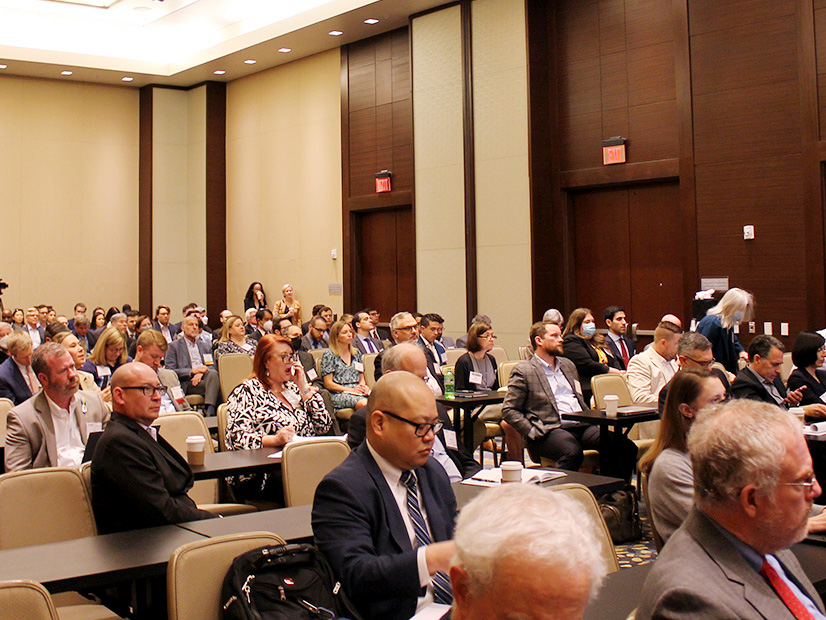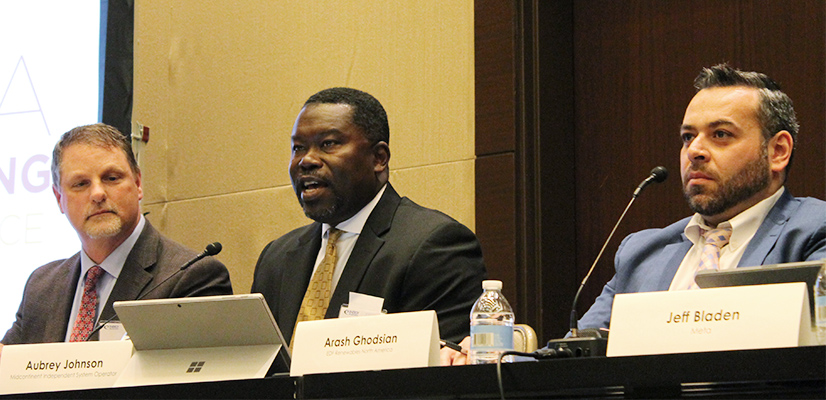
WASHINGTON — Anxiety over the clogged interconnection queues of RTOs and the ever more pressing need for more interregional transmission saturates the energy industry, and the near complete failure of the Texas Interconnection last year still looms large.
This was evident based on some of the discussions last week at the Energy Bar Association’s annual meeting, held in-person for the first time in three years at the Marriott Marquis Washington, DC hotel. Unlike several of the post-COVID-lockdown conferences, in which attendance might be capped or some speakers appear virtually, this was a fully in-person event; meeting rooms and the banquet hall were filled nearly to capacity.
In a panel on generation interconnection Wednesday, moderator Jason Stanek, chair of the Maryland Public Service Commission, paused to inform the audience that the front row of seats was open to those standing in the back of the room. It had remained open despite his joke at the beginning of the session, when he noticed “MISO people coming in late today. … You should be in the front row.”
Indeed, Stanek was sort of the odd man out: The panel was made up of both current and former MISO employees and a MISO stakeholder. But he noted that the lack of interstate transmission was a nationwide problem, referencing his state’s ambitious clean energy targets and neighboring Pennsylvania’s rejection last year of the Independence Energy Connection, which would have consisted of two lines in Western and Eastern Maryland connecting to existing lines across the border.
 Maryland PSC Chair Jason Stanek | © RTO Insider LLC
Maryland PSC Chair Jason Stanek | © RTO Insider LLC“The queue backlogs are not the problem, but a symptom of a much larger problem,” Stanek said, reporting what he has heard as a member of the Joint Federal-State Task Force on Electric Transmission at a meeting just the week before the conference. (See FERC-State Task Force Considers Clustering, ‘Fast Track’ to Clear Queues.)
Aubrey Johnson, executive director of system planning and competitive transmission at MISO, noted that FERC recently approved an RTO proposal to give generators the opportunity to cut the number of days in its interconnection process. (See FERC Allows Quicker MISO Interconnection Queue Option.)
“So fundamentally, the queue is continuing to make improvements, but in many ways, we’re trying to use the queue today for things that it was not originally intended to do,” he said. “I certainly believe we should continue to work on queue reform and queue improvements. … But I also want us to think about what the real issues are.”
Johnson noted that MISO’s queue currently has about 800 projects worth about 126 GW, with about 60 to 70% of that being solar. “With a 200-GW system and a 130-GW peak — I don’t think all those projects in the queue are actually needed.” Only about 20% of projects that enter the queue actually reach a generator interconnection agreement, he said. “The real question should be: How do we deal with that 20%?”
Stanek quoted Massachusetts Department of Public Utilities Chair Matthew Nelson at the task force meeting: “‘Being in the queue should mean something.’
“The fact that only 20% of these projects, at most, ever actually make it to fruition shows us that we have an issue with gaming; with queue squatting,” Stanek said.
Jeff Bladen, global director of energy for Facebook parent company Meta, agreed that in general, not all of the projects in the queue are needed. But the former executive director of digital strategy for MISO noted that “there’s a lot more that needs to get built than has historically gotten built if we’re going to move forward with the electrification of many different sectors, and the growth of things like data centers is a signal of how much” clean energy is going to be needed. “It’s hard to believe it’s just going to be 20%.”
Meta is not just a rebranding of Facebook; it’s also the parent for photo-sharing service Instagram, messaging service WhatsApp and virtual reality producer Reality Labs (formerly known as Oculus), among other digital service companies. They collectively require a massive amount of data processing, which in turn requires a massive amount of energy for Meta’s 17 data centers across the U.S. — all of it renewable, according to the company.
More important than the queue backlogs, Bladen argued, is “the reliability of the grid. We’re starting to see the grid fray as we have more and more critical weather emergencies. … The reliability of the grid is an area of increasing and probably primary focus for us as we move forward.”
Meta has set a goal of net-zero emissions across its entire operations by 2030, “which is unlocked by transmission. Our core energy strategy is relatively simple: reliable, affordable and sustainable. And there are very few things that we think about as investments or areas of focus for policy that get us all three, and one of those few is transmission,” Bladen said.
Q&A
Stanek asked the panel if FERC needed to implement a rule on interconnection, or if the RTOs could fix their respective problems themselves.
“Having some leadership from FERC would generally be helpful,” Bladen answered. “Some general direction of what the expectations are is important so that the stakeholder processes have something to work towards. When they don’t have something to work towards … you end up with various vested interests running into each other, and it’s very difficult for an RTO to resolve those. …
“I think there’s a role for FERC to play; just don’t be overly prescriptive about exactly how you accomplish the outcome.”
 From left: Dehn Stevens, MidAmerican Energy; Aubrey Johnson, MISO; and Arash Ghodsian, EDF | © RTO Insider LLC
From left: Dehn Stevens, MidAmerican Energy; Aubrey Johnson, MISO; and Arash Ghodsian, EDF | © RTO Insider LLCDehn Stevens, vice president of transmission development and planning at MidAmerican Energy, concurred. “I’ve heard someone say, or several someones say, that what we need is one interconnection queue, one system model, across everywhere. And I just have to say that’s the worst idea I’ve ever heard.
Rather, “an appropriate role for FERC would be to require accountability. If the regions are coming up with queue reforms, have a feedback loop about how it’s going,” with the RTOs filing annual reports on their progress.
One audience member told the panel that his clients often complain about what they see as unfair cost allocation, as their projects are somehow the ones that trigger the need for expensive transmission upgrades. At the same time, they are told that these upgrades are not showing up as needed in the RTOs’ transmission planning process. He asked what the difference was between interconnection studies and transmission planning studies, and “why, it seems to me, there’s a big disconnect between what’s showing up” in each.
“Fundamentally, generator interconnection planning is about trying to stress the local system — to make sure all the generators in a local area can operate reliably,” Stevens answered.
On the other hand, “long-term planning then looks at how all those generators will most likely be dispatched in the seasons that we’re trying to analyze. … So there’s a fundamental difference between the two paradigms in the way that the planners look at the world. …
“In order to make not every generator on the hook for some tiny slice of everything from coast to coast, we apply significance criteria,” which determine the amount of impact on a transmission facility a generator has to have before it’s responsible for upgrade costs. “What that means is there could be issues accumulating, but no one is yet held responsible … until the fateful day comes when a generator connects to the grid, and they have an impact above the significance factor cutoff,” Stevens continued.
“I would just say we can’t forget that all of the generators that came before that one all got the benefit of not having to have any responsibility to fix [the grid] because we all decided it was better to not hold everyone hostage across a wide area.”
Arash Ghodsian, senior director of transmission and policy for EDF Renewables North America — and another former MISO employee — said that proactive planning would eliminate that problem. “Unfortunately, until we get there, you’re going to hear that, because rather than me fixing the line for the X percentage that I have contributed to, I often get, ‘well, we need to rebuild the whole line.’”


